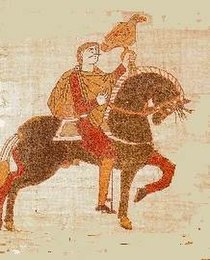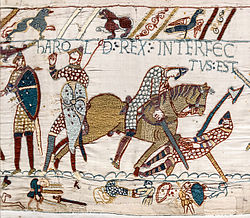Wikijunior:Kings and Queens of England/More Anglo-Saxons
Edward the Confessor (1042-1066)
[edit | edit source]Edward the Confessor was born in Islip, Oxfordshire around the year 1004. He was the penultimate Anglo-Saxon King of England and the last of the House of Wessex, ruling from 1042 until his death in 1066. His reign marked the continuing disintegration of royal power in England, which was replaced by more power going to the great territorial earls.
Edward, along with his brothers, was taken to Normandy by his mother Emma, the sister of the Duke of Normandy, Richard II, in 1013 to escape the Danish invasion of England. In his quarter-century of Norman exile, Edward developed an intense personal piety and gained a familiarity with Normandy and its leaders that was to influence his later rule.
In 1036 he returned to England with his brother Alfred to try to displace Harold Harefoot as king, but this failed, Alfred was caught and brutally killed by Earl Godwin with a red hot poker. Luckily, Edward escaped back to Normandy. In 1041 he was invited back by the Anglo-Saxon lay and ecclesiastical nobility to be co-ruler with Harthacanute, and when Harthacanute died in June 1042, Edward ascended the throne. He was crowned at Winchester Cathedral on 3 April 1043.
Edward's Reign
[edit | edit source]Edward's reign was marked by peace and prosperity, but to rule effectively Edward had to come to terms with three powerful nobles. The first of these was Godwin, Earl of Wessex, who was firmly in control of Wessex which had formerly been the heart of the Anglo-Saxon monarchy. Next there was Leofric, Earl of Mercia, and in the north there was Siward, Earl of Northumbria.
Edward favoured Normans, however, and this frustrated both Saxon and Danish nobles and fueled the growth of anti-Norman opinion led by Godwin, who had become the king's father-in-law in 1045. The breaking point came when Edward appointed the then Bishop of London, the Norman Robert Jumièges, as Archbishop of Canterbury rather than Godwin's preferred choice. There was a bloody riot at Dover between the townsfolk and Edward's kinsman, Eustace, Count of Boulogne. After Godwin refused to punish the townsfolk, Leofric and Siward backed King Edward and Godwin and his family were all exiled in September 1051. Edward's queen, Eadgyth, who was also Godwin's daughter, was sent to a nunnery at Wherwell. Godwin returned with an army a year later forcing the king to restore his title and send away his Norman advisors. Godwin died in 1053 and a Norman, Ralph the Timid, was given Herefordshire but his son Harold accumulated even greater territories for the Godwins and later became Edward's successor.
Marriage and Heirs
[edit | edit source]Edward married Godwin's daughter, Eadyth of Wessex, on 23 January 1045. They had no children. His nearest heir would have been a nephew, also called Edward, who was born in England but spent most of his life in Hungary. He had returned from exile in 1056 and died not long after, in February the following year. So Edward made his great nephew Edgar Atheling his heir, but Edgar did not have much of a following among the nobles and this led to Harold Godwinson being declared king
Death and Legacy
[edit | edit source]Edward died in January 1066. The cult that grew up around him in the mediaeval period under the later Plantagenet kings has had a lasting impact on English history. Edward had founded Westminster Abbey, where he was buried, sometime between 1045 and 1050, and it was consecrated on 28 December 1065. When Henry II came to the throne in 1154, he united the Saxon and Norman royal lines. To reinforce his legitimacy, the cult of King Edward the Confessor was promoted. Westminster Abbey was redesigned to contain a shrine to Edward, which remains there to this day. After much lobbying, Edward was made a saint by Pope Alexander III in 1161. At the time when Edward was made a saint, there were two types: martyrs and confessors. Martyrs were people who died in the service of the Lord, and confessors were people who died natural deaths. Since Edward died a natural death, he was styled Edward the Confessor.
The Roman Catholic Church now regards Edward the Confessor as the patron saint of kings, difficult marriages and separated spouses. After the reign of Henry II, Edward was considered the patron saint of England until 1348 when he was replaced in this role by Saint George. He remains the patron saint of the Royal Family.
Harold Godwinson (1066)
[edit | edit source]
Harold Godwinson or Harold II of England was born around the year 1022 in Wessex. He ruled from 5 January to 14 October 1066, when he was killed at the Battle of Hastings. Harold's father was Godwin, the powerful Earl of Wessex. Godwin married twice and it was his second marriage that produced Harold, Tostig and Edith.
Harold was made Earl of East Anglia in 1045, and then accompanied his father, Godwin, into exile in 1051. A year later he helped Godwin regain his position. When Godwin died in 1053, Harold inherited the earldom of Wessex, which made him the second most powerful figure in England after the king. In 1058 Harold also became Earl of Hereford, and he replaced his late father as the focus of opposition to growing Norman influence in England under the restored Saxon monarchy of Edward the Confessor. In 1062 and 1063 Harold then successfully fought a series of campaigns against the ruler of Gwynedd, Gruffydd ap Llywelyn, who had conquered all of Wales. About 1064, Harold married Aldith, daughter of the Earl of Mercia, and widow of Gruffydd ap Llywelyn. By Harold, Aldith had two sons, Harold and Ulf. Harold also had several illegitimate children by his mistress, Eadgyth.
In 1064, Harold was shipwrecked in Normandy and was turned over to the court of Duke William. William considered himself to be the successor of the childless Edward the Confessor, and got Harold to swear an oath to support William as the future king of England. In 1065 Harold supported a Northumbrian rebellion against taxes levied by his brother Tostig and replaced him with Morcar, the Earl of Northumbria. This strengthened his acceptability as Edward's successor, but divided his own family. Tostig went into alliance with King Harald Hardrada of Norway. In January 1066, upon Edward's death, Harold was proclaimed king by the Witenagemot who, under Anglo-Saxon law held the ultimate authority to convey kingship.
Harold's Reign
[edit | edit source]
Harold's position as king, though, was much disputed and the country was invaded, first by Harald Hardrada of Norway and then by William, Duke of Normandy. Harold offered his brother, Tostig, a third of the kingdom, and Tostig asked what Harold would offer the king of Norway. "Six feet of ground or as much more as he needs, as he is taller than most men," was Harold's response according to Henry of Huntingdon. Invading what is now Yorkshire in September, 1066, Harald Hardrada and Tostig defeated the English earls, Edwin of Mercia and Morcar of Northumbria, at the Battle of Fulford near York on 20 September. But they were in turn defeated and killed by Harold's army five days later at the Battle of Stamford Bridge. Harold now forced his army to march 240 miles to meet William, who had landed about 7,000 men in Sussex, on 28 September. Harold established his army near Hastings, and on 14 October the two armies clashed at the Battle of Hastings, near the present town of Battle. Harold was killed and his forces routed. According to tradition, Harold was killed by an arrow in the eye, but the victim depicted in the Bayeux Tapestry is anonymous. Whether he did, indeed, die in this manner, or was killed by the sword, is unknown.
Edgar Atheling (1066)
[edit | edit source]
Edgar Atheling was born around the year 1051. Born in Hungary, he was also known as Edgar the Outlaw. The Anglo-Saxon name Atheling means "man of noble blood, chief, prince" and was used to designate the sons of the king. Edgar was the only son of Edward the Exile, heir to the English throne and grandson of King Edmund II Ironside. Upon his father's death in 1057, Edgar was nominated as heir apparent by the King Edward the Confessor. Edgar was brought up at Edward's court, together with his sisters Margaret and Christina. However he was too young at the time of the king's death in January 1066 to defend the country against invasion and his election as king after Harold's death was no more than a symbolic token of defiance against the invading Norman forces. After Harold II's death he was proclaimed, but never crowned, King of England. Edgar relied largely for his support upon Archbishop Stigand and upon Earls Edwin of Mercia and Morcar of Northumbria and, when this weakened within a matter of days of the witan that proclaimed him king, Edgar was forced to submit to William at Berkhamstead in either late November or early December 1066.
William treated Edgar well. Seeing political advantage, he kept him in his custody and eventually took him back to his court in Normandy. Edgar joined in the rebellion of the earls Edwin and Morcar in 1068 and, defeated, he fled to the court of Malcolm III of Scotland. The next year Malcolm married Edgar's sister Margaret, and agreed to support Edgar in his attempt to claim the English crown. In exchange, Edgar married Malcolm's sister, another Margaret. Edgar now made common cause with Sweyn Estridson, the king of Denmark and nephew of Canute, who believed he was the rightful king of England. Their combined forces invaded England in 1069, and they captured York. William marched on the north, devastating the land as he went. He paid the Danes to leave, and Edgar fled back to Scotland. He remained there till 1072 when William forced Malcolm to accept a peace treaty that also required Edgar to be exiled. Edgar eventually made his peace with William in 1074, but he never fully gave up his dreams of regaining the throne of England. He supported Robert, Duke of Normandy, against William II in 1091 and again found himself seeking refuge in Scotland. He also supported his nephew, Edgar, in gaining the Scottish throne, overthrowing Donald III.
Around 1098 he went to Constantinople, where he may have joined the Varangian Guard of the Byzantine Empire. Later that year he was given a fleet by Emperor Alexius I so he could help in the First Crusade, and Edgar brought reinforcements to the crusaders at the Siege of Antioch. He was taken prisoner during battle in 1106 whilst fighting for Duke Robert against King Henry I of England. He returned to England where Henry pardoned him, and he retired to his country estate in Hertfordshire. His niece Edith (renamed Matilda) had married Henry I in 1100. Edgar is believed to have returned to the Kingdom of Scotland late in life, perhaps around the year 1120, and was still alive in 1125, but may have died soon after, in his early seventies.
